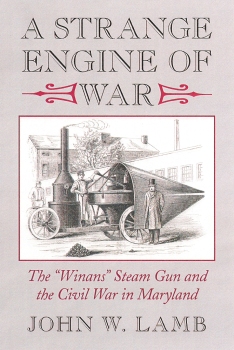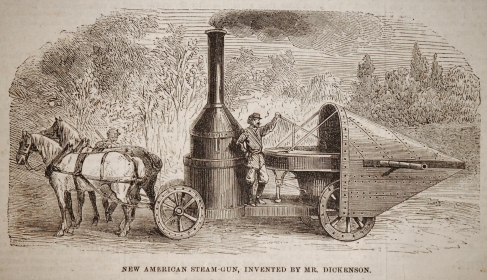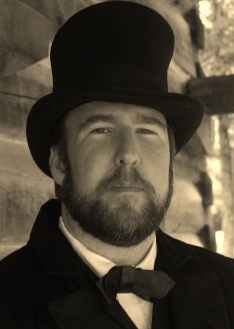Steam powered weapons are a staple of steampunk literature, art, and fashion, but in 1861 Harper’s Ferry played a part in the story of the “Winans” Steam Gun. “Its tough to imagine Harper’s Ferry as enemy territory, but in May 1861, Federal troops captured a steam gun, allegedly built by Maryland industrialist Ross Winans as it was being transported to Harper’s Ferry” says John Lamb, author of A Strange Engine of War: The “Winans” Steam Gun and Maryland in the Civil War. “ The men captured with it hoped to sell it to the Confederate troops there.”
While the gun never made it to Harper’s Ferry, Lamb will share its story with patrons of Steam at Harper’s Ferry on May 6. “Steam is a steampunk art and gift shop. What better place to share the story of such an outlandish, but entirely real Civil War device?” Lamb says. “Steampunk is a literary, artistic, fashion, and musical movement that starts with Victorian aesthetics, keeps things steam powered while taking technology and society in different directions. While contemporary to us, its roots go back to the 19th Century.”
“One of the frequent themes of steampunk literature, is inventors toiling in obscurity on their creations – that is a pretty fair synopsis of the steam gun’s creation by Charles Dickinson and William Joslin,” Lamb says. What started as an effort to build a hand powered “centrifugal” gun by the men, grew into a steam powered weapon that rocketed to national prominence in the wake of the April 19, 1861 Baltimore Riot.
The gun’s menacing appearance and its arrival on the public stage at the height of anxiety after the riots helped bury its true origin, and forever linked it to noted Maryland industrialist Ross Winans through newspapers at time and through many books and historical articles over the years. While the basic facts of the story were talked about  at the time, they soon faded from memory, according to Lamb. “Newspaper articles around the 50thanniversary (1911), helped bring out the story of its last days,” Lamb says. “During the 100th anniversary (1961), a replica was built for a reenactment of the gun’s capture. In 2007, Mythbusters on the Discovery Channel put the idea of the gun to the test. My book, published in 2011, continues the gun’s 50 year cycle of returning at key anniversaries for another round of publicity.”
at the time, they soon faded from memory, according to Lamb. “Newspaper articles around the 50thanniversary (1911), helped bring out the story of its last days,” Lamb says. “During the 100th anniversary (1961), a replica was built for a reenactment of the gun’s capture. In 2007, Mythbusters on the Discovery Channel put the idea of the gun to the test. My book, published in 2011, continues the gun’s 50 year cycle of returning at key anniversaries for another round of publicity.”
Lamb’s interest in the gun was sparked when he found an engraving of it while working on another project in the early 1990s. “My curiosity about it began simply – what was it, was it dangerous? What happened to it? The more source materials I read, the less sense it all made – with good reason – the accepted account of events had little to do with what really happened.” Lamb says. “I worked on it here and there as I could and slowly a more complete account of the gun emerged. Being on Mythbusters spurred me to complete my work and put out a book, which came out in 2011. I have really enjoyed uncovering the true story of the Steam Gun, and am looking forward to sharing it with gallery guests at Steam at Harpers Ferry.”
If You Go: Historical Presentation/ Book Signing with John Lamb, Author of A Strange Engine of War: The “Winans” Steam Gun and Maryland in the Civil War, 2-4 p.m., Sunday, May 6, Steam at Harper’s Ferry, 180 High Street, 1B (on the stairs), Harper’s Ferry, WV, 25425. For more information visit, www.steamatharpersferry.com, call 304-885-0094 or send an email to info@steamatharpersferry.com
About John Lamb
John W. Lamb, author of A Strange Engine of War: The “Winans” Steam Gun and Maryland in the Civil War works in communications and development in the non-profit sector, is interested in Maryland’s Civil War history, 19th Century technology and shapenote singing, and appeared on the Discovery Channel’s *Mythbusters* series episode regarding the Winans Steam Gun. He lives in Harrison, Tennessee, with his wife and 3 children.
About Steam
Steam at Harper’s Ferry is a Victorian/Steampunk themed art gallery and gift shop located in the historic lower town of Harper’s Ferry, West Virginia. Steam at Harper’s Ferry has quarterly openings and features local and regional artists.


